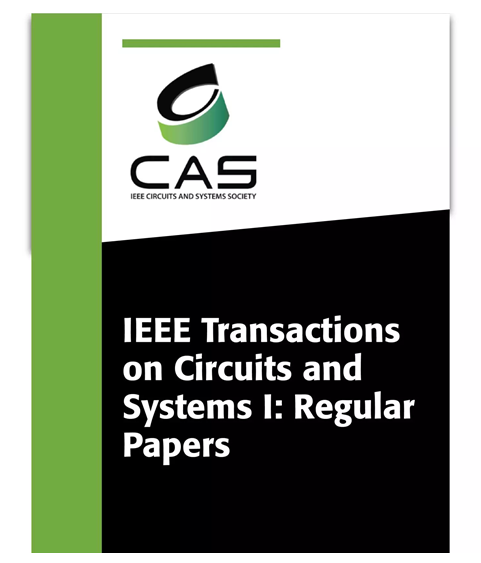电路传递矩阵:一种扩展多体系统传递矩阵法以提高电路分析效率的新方法
IF 5.2
1区 工程技术
Q1 ENGINEERING, ELECTRICAL & ELECTRONIC
IEEE Transactions on Circuits and Systems I: Regular Papers
Pub Date : 2025-03-18
DOI:10.1109/TCSI.2025.3531876
引用次数: 0
摘要
为了解决大规模电路分析中高计算复杂性的挑战,提出了电路传递矩阵方法,利用电气系统和机械系统之间的强烈相似之处。该方法建立在多体系统传递矩阵法的基础上,该方法在复杂机械系统中取得了重大突破并得到广泛应用,并将其应用扩展到电路分析。与传统的模型简化技术不同,电路转移矩阵方法采用了系统状态向量的“转移”和转移矩阵的“组装”概念,有效地降低了系统方程的阶数,显著提高了计算效率。这种降阶模型允许设计师在有限的设计周期内更有效地分析和综合系统的动态行为。本文介绍了电路传递矩阵法的计算流程,从状态向量的定义到传递矩阵的调用和装配,再到传递方程的求解。导出了基本成分传递矩阵,并在此基础上提供了导出组合元素传递矩阵的方法,以及相应的示例。随后,举例说明了线性交流分析、线性链系统暂态分析、线性闭环系统暂态分析和一般非线性系统暂态分析的详细计算过程。通过与基于SPICE的方法的比较,验证了该算法的准确性。最后,与SPICE算法速度的比较表明,SPICE算法的渐近时间复杂度为$O(n^{3})$,而电路传递矩阵法的复杂度仅为$O(n)$,显著提高了计算效率。本文章由计算机程序翻译,如有差异,请以英文原文为准。
Circuit Transfer Matrix: A Novel Approach to Enhancing Circuit Analysis Efficiency by Extending the Transfer Matrix Method for Multibody System
To address the challenge of high computational complexity in large-scale circuit analysis, the Circuit Transfer Matrix Method is proposed, drawing on the strong parallels between electrical and mechanical systems. This method builds upon the Transfer Matrix Method for Multibody Systems, which has seen significant breakthroughs and widespread use in complex mechanical systems, extending its application to circuit analysis. Unlike traditional model-reduction techniques, the circuit transfer matrix method employs the concepts of ‘transfer’ of system state vectors and the ‘assembly’ of transfer matrices, effectively reducing the order of the system’s equations and significantly improving computational efficiency. This reduced-order model allows designers to analyze and synthesize a system’s dynamic behavior within a limited design cycle more efficiently. The text presents the computational workflow of the Circuit Transfer Matrix Method, from the definition of state vectors to the invocation and assembly of transfer matrices, followed by the solution of the transfer equations. The fundamental component transfer matrices are derived upon which the method for deriving the transfer matrices of combined elements is provided, along with a corresponding example. Subsequently, examples are provided to illustrate the detailed computational processes for linear AC analysis, transient analysis of linear chain systems, transient analysis of linear closed-loop systems, and transient analysis of general nonlinear systems. The accuracy of the algorithm is validated by comparisons with methods based on SPICE. Finally, a comparison of the algorithm speed with SPICE reveals that SPICE has an asymptotic time complexity of $O(n^{3})$ , while the Circuit Transfer Matrix Method has a complexity of only $O(n)$ , significantly enhancing computational efficiency.
求助全文
通过发布文献求助,成功后即可免费获取论文全文。
去求助
来源期刊
CiteScore
9.80
自引率
11.80%
发文量
441
审稿时长
2 months
期刊介绍:
TCAS I publishes regular papers in the field specified by the theory, analysis, design, and practical implementations of circuits, and the application of circuit techniques to systems and to signal processing. Included is the whole spectrum from basic scientific theory to industrial applications. The field of interest covered includes: - Circuits: Analog, Digital and Mixed Signal Circuits and Systems - Nonlinear Circuits and Systems, Integrated Sensors, MEMS and Systems on Chip, Nanoscale Circuits and Systems, Optoelectronic - Circuits and Systems, Power Electronics and Systems - Software for Analog-and-Logic Circuits and Systems - Control aspects of Circuits and Systems.

 求助内容:
求助内容: 应助结果提醒方式:
应助结果提醒方式:


